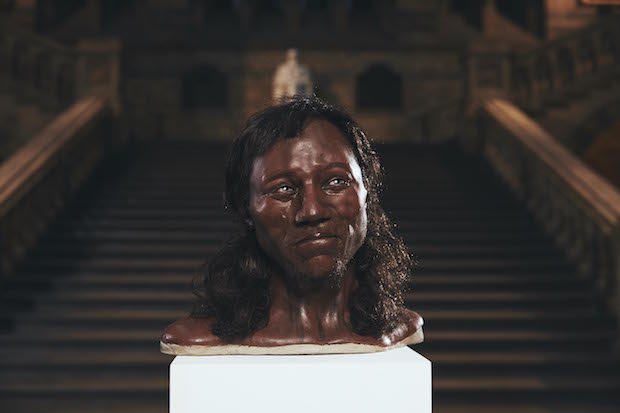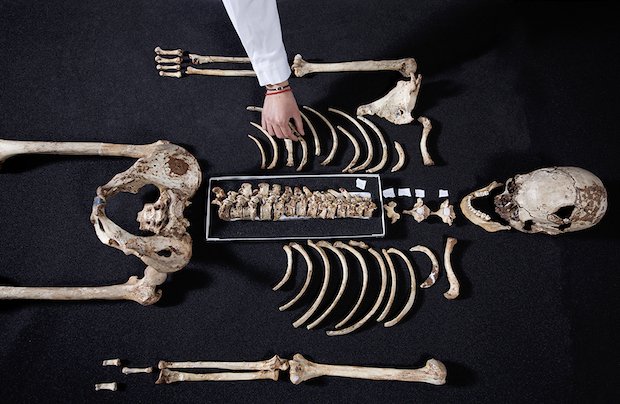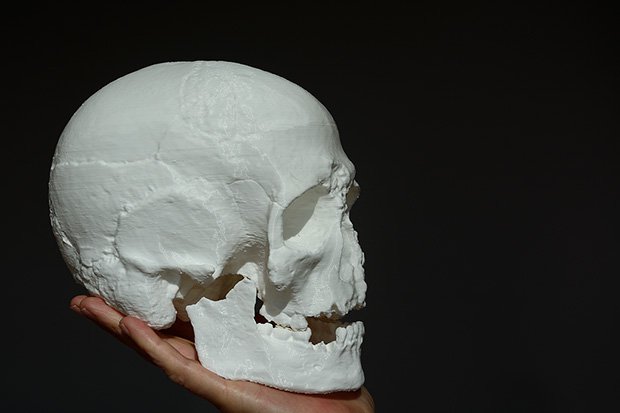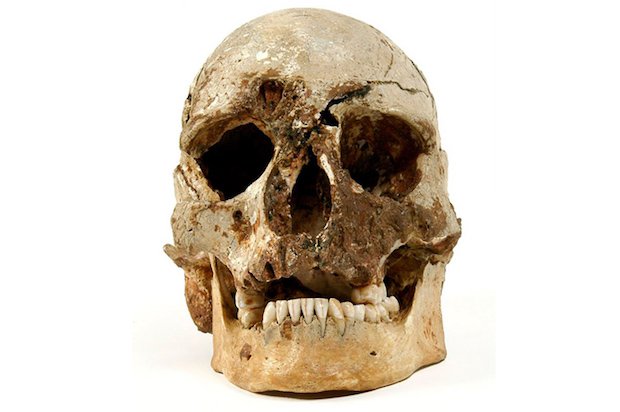
© Channel 4/Plimsoll Productions
Posted on 02/18/2018 8:24:16 PM PST by null and void

© Channel 4/Plimsoll Productions
The Cheddar Man after Kennis & Kennis' reconstruction.
On Sunday, Channel 4 will broadcast a documentary unveiling the face of what is believed to be the oldest complete British skeleton to be discovered. The Cheddar Man has warranted such comprehensive coverage because of his surprising complexion. Unlike the white skin and fair hair researchers had expected to belong to the first modern Briton, the man who lived 10,000 years ago and died in his twenties is believed to be black, with dark, curly hair and blue eyes.
In his heyday, he was a 5ft 5” hunter-gatherer whose family had emigrated from Africa via the Middle East, but in 2018 he is the subject of a prime-time television documentary and thousands upon thousands of social media posts, beyond the comprehension of a man who lived in a ‘survival of the fittest' environment. His big reveal some 10,000 years on would also not have been possible without the latest 3D scanning and 3D printing technology.
Heritage inside his DNA
Cheddar Man’s skull was discovered in 1903 at Gough’s Cave in Cheddar Gorge, Somerset. It had been well preserved thanks in large part to the cool limestone surroundings of the cave, and has since been showcased at Natural History Museum in London. In a joint project between the museum and the University College London, researchers leant on the latest DNA sequencing techniques to kickstart a process which would lead them to discover his age, his background, and some distinctive characteristics.
DNA was extracted from an inner ear bone, among the densest in the human body and thus able to maintain DNA traces for centuries, after researchers drilled into the skull to retrieve bone powder. Shotgun DNA sequencing was then carried out. This method involves millions of fragments of DNA being distributed randomly across the genome, creating a library of DNA. Researchers then mapped their findings against a modern human genome, before Dr Tom Booth, a postdoctoral researcher, sent the information to a bioinformatics lab, where a portrait was developed.

© Channel 4/Plimsoll Productions
The complete skeleton of the Cheddar Man discovered in 1903.
Artists’ impression
At this stage, Kennis & Kennis Reconstructions were approached to develop a 3D model from the data gathered. Adrie and Alfons Kennis, identical twins, are specialists in the area of performing reconstructions of fossilised frameworks, better known as Paleo-art. They use 3D scanning and printing technology to create their art for two reasons: The first, to protect the original, often fragile fossil they're working with, and the second, to take advantage of the precise measurement capabilities.
The Kennis brothers assessed the Cheddar Man’s skeleton, before performing a 3D scan of the skull. This data was then sent in an STL. file to Minke Van Voorthuizen, of Minke Products, to 3D print the skull. Van Voorthuizen is Kennis & Kennis’ trusted ally. When the pair require the assistance of 3D printing technology, she is their first port of call. A product designer based in Arnhem, The Netherlands, Van Voorthuizen has been ‘keeping informed’ with 3D printing technology since 2003, purchased her own FDM 3D printing systems in 2013, and in the interim, was using service bureaux to 3D print parts for her projects. Van Voorthuizen now concedes she’s ‘a little bit addicted’ to her Ultimaker machines - her participation in projects like the Cheddar Man skull reconstruction, in addition to her turning CAD designs into real-life objects within hours, serving to feed it.
Altamura and the Iceman
Speaking to TCT, Van Voorthuizen revealed she has previously printed the skeletons of a sabre tooth tiger and multiple dinosaurs, and also partnered with the Kennis brothers to bring to life the Altamura Man.
“The story of the Altamura Man is that he fell in the cave and he never came out of it,” – a team of speleologists discovered his remains in 1993, and deduced that he had fallen into a remote spot, got stuck, and died of starvation or lack of water intake – “They found him upside down, tangled in stone, and even nowadays, they are unable to get him out,” – he was entombed amongst calcium carbonate concretions, formed from water trickling down the cave walls – “They waited years and years to have the scanning technology to ‘get him out’. I’m surprised it’s not getting the [coverage] like Cheddar Man, because it’s a very sad story.”
In this case, DNA was extracted from the shoulder bone, but the process from there on was comparable to the Cheddar Man. Kennis & Kennis conducted 3D scans with Artec 3D devices, outsourced the 3D printing of this data to Minke Products, and from there reconstructed the face. They had also successfully used this approach to reconstruct Otzl the Iceman, a mummy discovered in 1991 near the Similaun mountain and Hauslabjoch on the border between Austria and Italy.
Searching for Cheddar Man
When it came to the Cheddar Man, and his impeccably well-maintained skull, “it was quite easy,” Van Voorthuizen surmises. It meant she had few tweaks to make to the STL. file, and could almost immediately proceed to print the Cheddar Man’s skull. Using an Ultimaker 2 Extended machine, the skull was built in one piece in around 13 hours, using PLA material, and PVA for the support pillars, printing in layers of 0.3mm. Since the skull would only provide the foundation for Kennis & Kennis’ reconstruction it needn’t be too detailed, so the 300-micron layer height was preferred to ensure a quick build. This part of the process, Van Voorthuizen confirms, also needed to be done swiftly so Channel 4 could demonstrate it through a time lapse during its documentary, First Brit: Secrets of the 10,000 Year Old Man.
The 3D printed model of Cheddar Man's skull.


© Minke Van Voorthuizen
Cheddar Man Skull
“What I like about this project, nowadays the printers are able to go a little bit faster, and I was able print the whole skull in one piece, and make a time lapse out of it,” Van Voorthuizen says. “For so many years it took so much time, like three days, maybe a week, and a time lapse is not possible when you have Channel 4 staying only for a short time. But it took 13 hours, which is quite quick.
“I’m using an FDM printer for [these projects]. The detail of the print is not always in the microsphere because it is [just] used for making the reconstruction, and actually the Cheddar Man’s cranium, skull and jaw were in good condition. Sometimes it’s more fragmented like Altamura Man, but the detailed information from Cheddar Man was good so it was not difficult to bring it alive three-dimensionally.”
The Manchester Method
But the Cheddar Man wasn’t yet brought back to life. Having 3D printed a replica of his skull, Van Voorthuizen handed the responsibility back to Kennis & Kennis. The Paleo-artists, as they had done previously with Otzl the Iceman, would harness the Manchester Method to demonstrate the Cheddar Man’s supposed facial features. This technique sees wooden pegs inserted into the skull, each representing the thickness of skin tissue, using information based on the age, gender and build of the Cheddar Man retained during the DNA sequencing phase. Prosthetic eyeballs were also inserted, before layers of clay are added to fill the face out, roughly depicting the shape and characteristics he possessed.
“It’s a broad idea of how [he] would have looked,” Alfons Kennis told Channel 4, “you can tell yourself, if you put your hand on your face, you can feel where your bone is very near to the skin. It’s easy to know what a reconstruction would look like where the flesh is thin – for example, the nasal bridge, the frontal bone – the skin is very good, so if you know the skull shape, it’s easy to know what people would look like. But what brings a lot of character to a person is the fullness of the lips, the shape of the nostrils, the shape of the tip of the nose, the folds of the eyes – and you can’t know this.”
Painting the picture
Throughout the Manchester Method reconstruction process, the wooden pegs guided the Kennis brothers, helping them to achieve a model as close to reality as possible. This would also mean implementing the skin colour, the single feature that most caught the attention of the British public as the results of the Cheddar Man project were publicised last week.
It was a surprise, also, for those involved. “I remember Adrie and Alfons were confronted by Channel 4 about the darker skin and they couldn’t believe it,” recalls Van Voorthuizen. “They said ‘we want proof, scientific proof’.” The researchers had proof, scientific proof, and revealed it to Kennis & Kennis towards the end of last summer. It gave a new layer of significance to the project, becoming more than just an impressive facial reconstruction, casting a spotlight on the history of Britons, and giving a better understanding of our origins – it is estimated 10% of White British ancestry is linked to the population of hunter-gatherer’s that included the Cheddar Man.

Natural History Museum
Close up of the Cheddar Man's skull.
The brothers worked on the reconstruction for nearly three months, and last week visited the Natural History Museum to unveil the model. It is the latest in a long line of reconstructions, and while it won’t be the last, it is certainly one of their more profound works to date.
“We were very curious to find out what he looked like,” Alfons added. “And with the new DNA information, it was really revolutionary. People define themselves by which country they’re from, and they assume that their ancestors were just like them. And then suddenly new research shows that we used to be totally different people with a different genetic makeup. It’s a story about migrations throughout history. People will be surprised. Maybe it gets rid of the idea that you have to look a certain way to be from somewhere. We are all immigrants.”
We’re all, too, increasingly reliant on technology, even those 10,000-years deceased. The Cheddar Man’s skull was discovered more than a century ago, and has been studied for decades since. Yet it wasn’t until 2017 when it was finally revealed who this man was and what he looked like. The team of researchers, modellers and designers, owe a debt to Lady Luck for the preservation of the Cheddar Man’s DNA for 10,000 years, but from there on it was their endeavour and their application of DNA sequencing, 3D scanning, 3D printing, and facial reconstruction techniques, that realised the look of the Cheddar Man.
“To go beyond what the bones tell us and get a scientifically-based picture of what he actually looked like is a remarkable, and from the results quite surprising, achievement,” commented Prof. Chris Stringer, Research Leader in Human Origins at the Natural History Museum.
“It’s been fantastic working with this exciting team, and getting to sample one of the most important human skeletons in the museum collection,” added Prof Ian Barnes, Research Leader in Ancient DNA at the Natural History Museum.
ping
Cheddar Man. Some hypothesize he was Curd-ish.
RIMSHOT!
You funny guy!
But I gotta admit, you do have a whey with words...
Cheesy, though.
Wasn’t that a Pearl Jam song, “Can’t Find a Cheddar Man”?
Gouda one!
I suspect Wisconsin has a trademark on that name.
The man’s a muenster!
If not, it was a wedge issue when the legislature held a vote on it...
5ft 5in and 10,000 years ago. Back then, he may have been taller than average. I was in Western Europe a bunch of years ago and there were lots of local guys there who were about 5ft 8ins. Amsterdam was ultra tall. France and England short. Really, what was the average height for humans back then?
I’m building a 3D printer right now.
Get back to me when you can print a ham sammich and a six-pack of beer.
KEWL! A kit or from scratch?
What did they scan to get the eye color and lip shape?
LOL! Agreed!
The DNA for the eye color and skin tones, the skull for the basic features adding known statistics of tissue thicknesses over key points, and known muscle attachment points and shapes. The article acknowledges that some of the soft tissues are not unambiguously defined by the skull, most notably the corners of the eyes, tip of the nose, shape of the nostrils, and shape and fullness of the lips.
How accurate those are is a function of the skill of the person doing the reconstruction.
Forensic reconstructions of modern remains have yielded busts that vary from looking like a photograph of the now identified person, to ‘close enough’ for a loved one to recognize.
I suppose some are far enough away that they aren’t recognized at all, but the success rate is still pretty good.
From what I recall he doesn’t look very different than he did 20 years. Except darker. Why?
He opted for P.C???
Lordy, Just tell the truth.
Disclaimer: Opinions posted on Free Republic are those of the individual posters and do not necessarily represent the opinion of Free Republic or its management. All materials posted herein are protected by copyright law and the exemption for fair use of copyrighted works.